False ceilings in the kitchen: features, varieties and choices
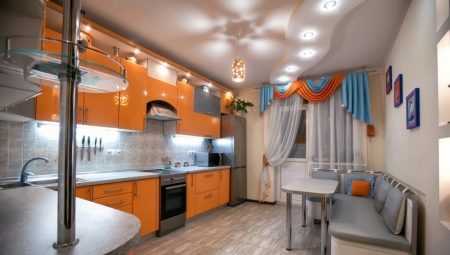
The choice of a ceiling in the kitchen should be taken with special responsibility, since this place in the house more than others suffers from the influence of hot air, steam, fatty evaporation. For this reason, you need to select an option that will be not only attractive in appearance, but also practical. People who are planning kitchen renovations should pay attention to suspended ceilings, as they have a lot of advantages and excellent characteristics.
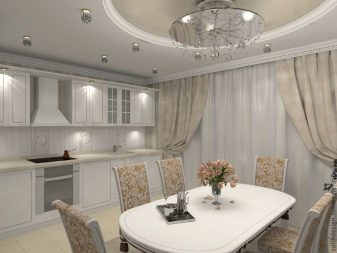
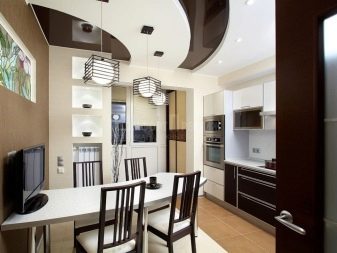
Peculiarities
Many people consider the suspended ceiling in the kitchen to be an element of the decoration of this room. It helps to conceal the uneven baseline, load-bearing beams, and also disguises pipes and ventilation ducts. It is also worth knowing that this design option will not only decorate the kitchen, but also hide the accumulated condensate, as well as the deposition of fat. When choosing a scheme and design for such a structure, you should not ignore the issue of its protection and purification.
The ceiling of this type can be called an excellent solution - it is characterized by practicality, as well as relevance. Its main elements include a frame, plates of hard or soft material. The design of the ceiling can be very different, so the owners will be able not only to renovate their kitchen, but also to make the dream of an ideal interior come true.
The lattice of the suspended structure module is attached to the ceiling with suspensions, while slabs are inserted into cells of a specific size.


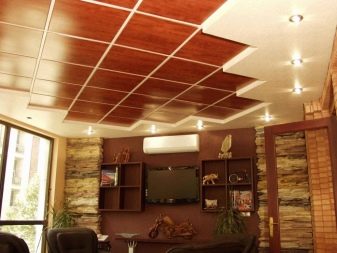
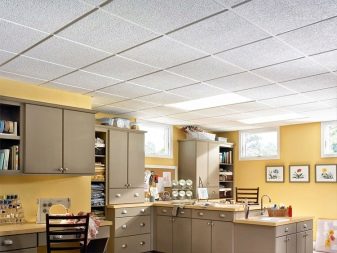
Between the base and the new ceiling there is a void in which communications and lighting items can be placed. False ceiling advantages:
- no need to perform complex preparatory work, since this type of system has the ability to hide flaws and surface irregularities;
- not laborious installation;
- accessibility to communications that are hidden in the structure;
- the accuracy and attractiveness of the design;
- the ability to create a soundproof layer;
- ease of dismantling;
- improving the quality of lighting, while reducing energy costs.

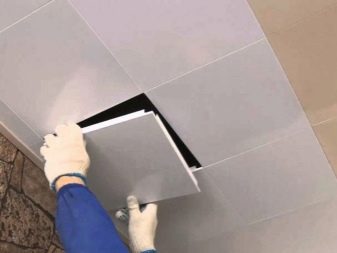
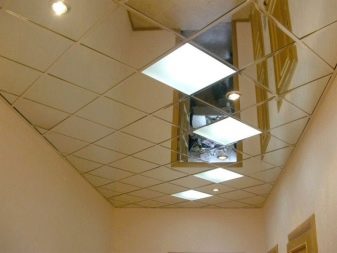

Like any other type of finish, suspended structures have some disadvantages:
- they take up a lot of kitchen space, so this is not the best option for a small apartment;
- high price;
- insignificant level of strength;
- low resistance to moisture and dampness.
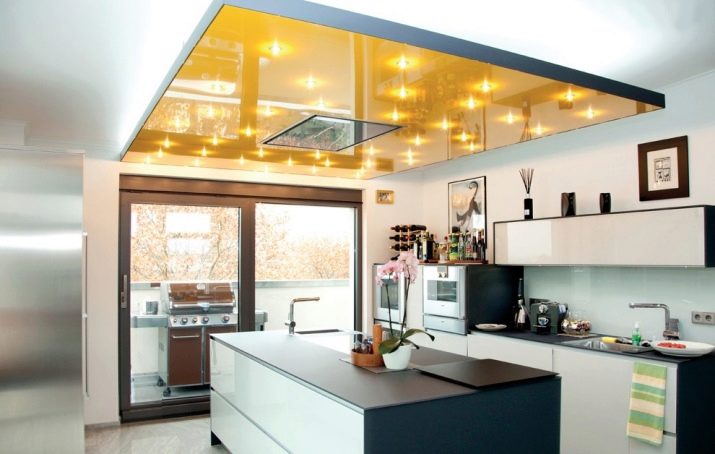
Views
Currently, the consumer may be faced with a wide variety of suspended ceilings, the main types of which are rack, cassette, plasterboard, multilevel, cellular, lattice, panel, tiled.
Rack and cassette
These systems are considered the most popular option, since they are characterized by a special coating of the elements, which increases the lifespan of the ceiling and preserves its appearance. Perforated ceilings made of steel and aluminum do not change color under the influence of the sun and are quite easy to clean. Hidden slats look like a smooth ceiling surface, but at the same time they can be decorated with a variety of design techniques. Also, the rack and pinion suspension structure is environmentally friendly and fireproof, waterproof, does not accumulate dust and does not grow moldy. By installing this type of ceiling, you can significantly reduce energy costs.
The disadvantage of the ceiling covering slat system is the lack of the possibility of partial dismantling.
The cassette ceiling, in turn, is durable, can be dismantled several times, and will also save the room from moisture and dampness. However, it is worth remembering that it is quite expensive and needs constant care.
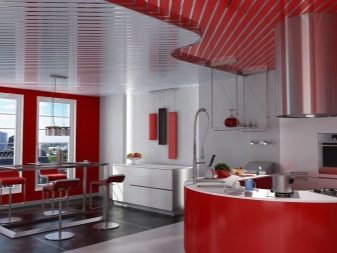
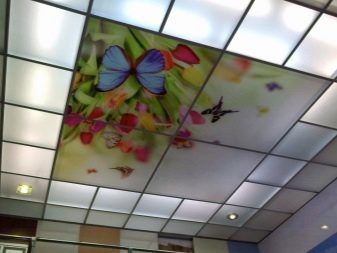
Panel
In this case, the panels can be either metal or glass. The advantages of this option include ease of installation, as well as its service life - more than 10 years. They also withstand heavy loads and are resistant to humidity, as well as temperature extremes. The disadvantage of a panel suspended ceiling can be called white, but it can be transformed if desired.

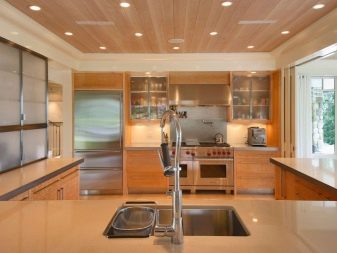
Plasterboard
A plasterboard ceiling for a kitchen is considered one of the most worthy options at the present time. Its disadvantages include the need for putty and finishing, as well as the inaccessibility of communications after the completion of work. Plasterboard moisture-resistant structures can become part of both single-tiered and multi-tiered ceilings, as well as stepped, which is considered their indisputable advantage.
After installing such a coating in the kitchen, you don't have to worry about replacing ceilings for about 20 years.
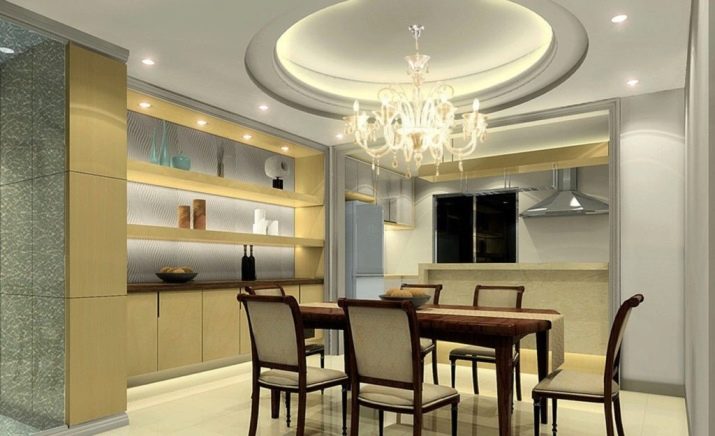
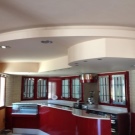
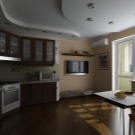
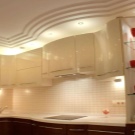

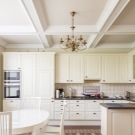
Color solutions
Choosing a false ceiling starts with its color. It is he who is responsible for the harmony of the room and the mood of the guests. The best option for the kitchen is considered to be white, as well as all kinds of pastel and light shades. Alternatively, you can use ivory, milky, light sand, cream coloring. If the kitchen is large, it can be decorated with a more intense color.
The owner must remember that the cold shade of the ceiling will visually move the object away, and the warm one will bring it closer. When both options are combined, you can visually narrow or expand the space of the room.
Plasterboard ceiling can be decorated in different ways. For example, the use of stucco molding would be a worthy solution.
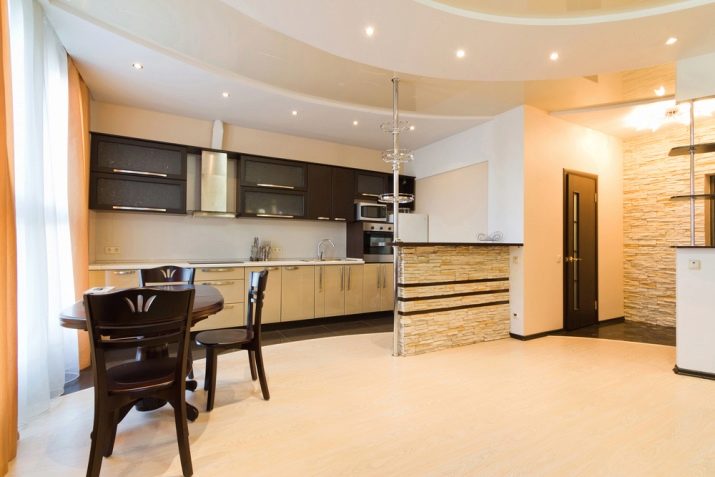
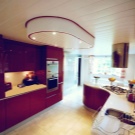
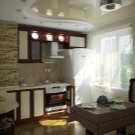

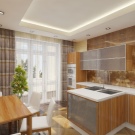
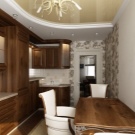
Design options
A studio apartment can have a clearly marked kitchen thanks to a split-level ceiling. On a small embossed decorative element, it is worth installing lamps on long cords or mounting several spotlights.If the kitchen is separate, then using a two-level ceiling, you can divide it into an area for dining and cooking. Stronger lighting is recommended above the butchering table, and softer lighting above the family gathering area.
The suspended plasterboard ceiling can have different combinations or be decorated with a pattern. If you mount a rounded structure or one that has bends, it will seem that the kitchen is more spacious. A rectangular ceiling is an opportunity to make your kitchen sophisticated and classic.
In the center of the two-level ceiling, you can make a screen with photowall-paper or mirrors, it will undoubtedly make a strong impression.
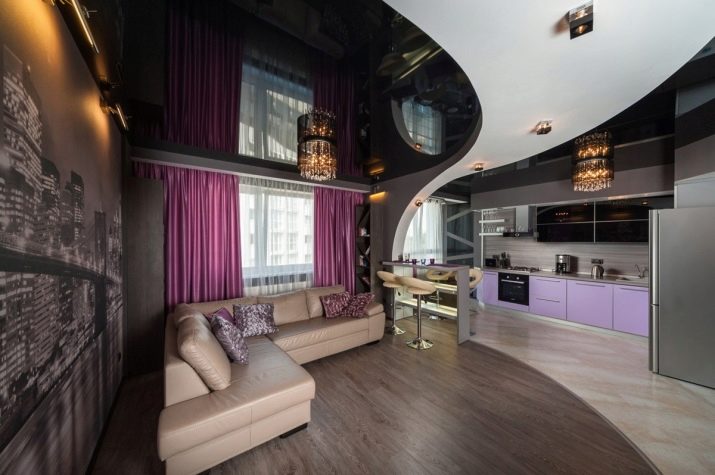
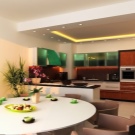
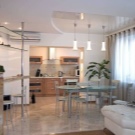
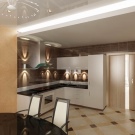
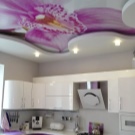

How to choose?
The material for the manufacture of ceilings can be different. The metal version is characterized by a wide range of models, since it does not create difficulties in processing, as well as excellent performance characteristics. The tree embodies individuality, respectability and aesthetics. Plaster structures often have a flat surface, they are simply painted.
When choosing a ceiling material for a kitchen, you should pay attention to the following parameters:
- fire safety;
- environmental friendliness;
- no deformation under the influence of temperature or humidity;
- aesthetic design;
- functionality.
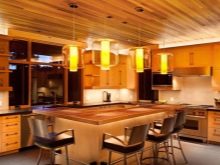
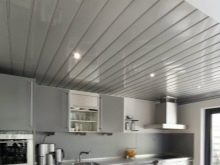
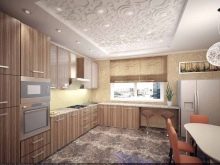
Installation nuances
The popularity of suspended ceilings for the kitchen is due to their practicality, as well as ease of installation. Before starting the installation of the structure, it is worth deciding on the number of suspensions that will be needed during operation. Often 8 pieces are required for 10 m2 of ceiling.
Stages of installation of a false ceiling in the kitchen.
- Laying engineering communications.
- Layout of the horizontal lines of the ceiling structure. The first mark should be made on the wall, taking into account that the ceiling will cover communications, beams and ledges. To avoid losses in height, it is worthwhile to clarify in advance the dimensions of the built-in elements.
- It is necessary to attach a profile along the drawn horizontal line, which has an L-shape. Hook or ring screws can be used for this procedure.
- Installation of guide profiles of different lengths should be carried out in the shape of an inverted T. The short profile has projections on both sides that must be inserted into the slots of the long profile.
- Leveling the structure with a level, adjusting the height of the suspensions. This stage should be carried out 72 hours after the completion of previous work.
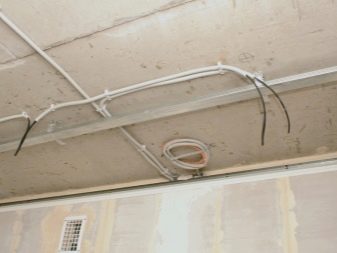
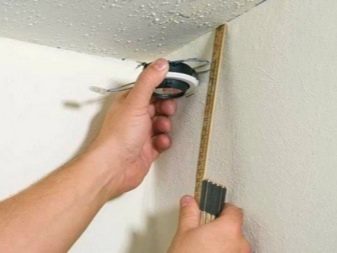
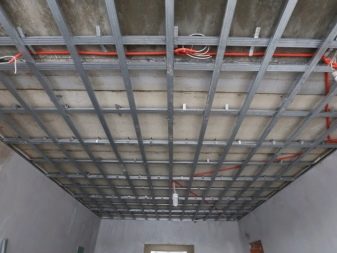
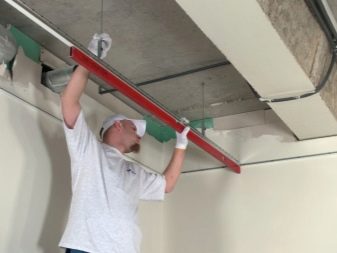
The basis of a plasterboard ceiling is a rigid frame. Due to the severity of this design, it is worth using metal profiles, as well as very durable fasteners. The installation of self-tapping screws should be carried out in increments of 0.2 meters, while taking into account lighting and ventilation devices. Stages of finishing plasterboard ceilings:
- filling the seams and grooves of self-tapping screws with putty;
- gluing seams with a serpyanka;
- re-puttying of seams and their grinding;
- surface painting.
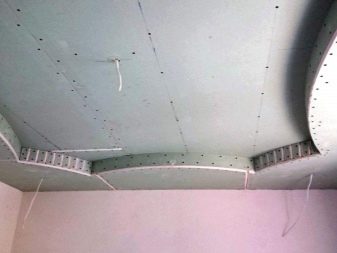
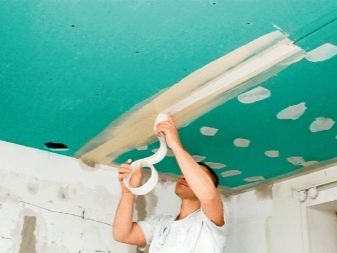
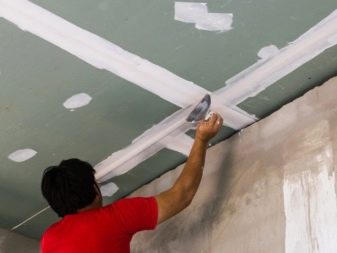

Installing a slatted ceiling does not involve anything complicated. The first step is to set the starting angle, and then attach the fasteners. Thanks to these features, it is possible to align the frame during the assembly process.
To make the kitchen look original, you can use multi-colored slats and jointing.

Beautiful examples
If you want to make an unusual suspended ceiling, it is better to give preference to plasterboard. Thanks to this material, it will be possible to translate the most daring ideas into reality. The rack and pinion version looks unusual and original, where each of the parts can have not only a classic, but also a figured relief. In this case, the slats can be of different colors or with patterns. Also, unusual lighting fixtures are built into the suspended ceilings.
The painted false ceiling will surely fit into the interior of the kitchen, the main thing is to choose the right color for the walls.
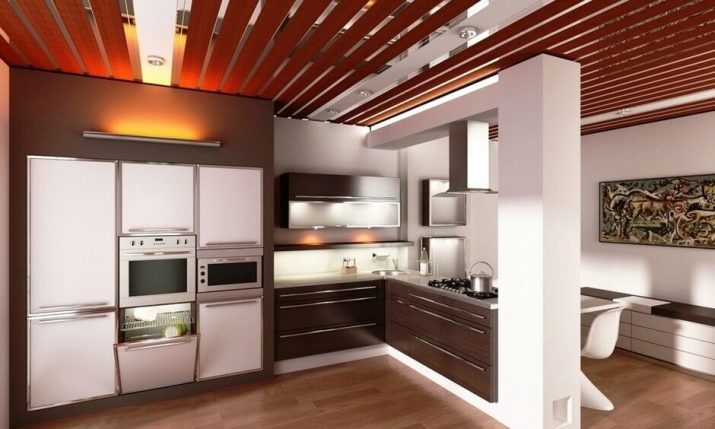
How to make a combined ceiling in the kitchen, see the next video.








